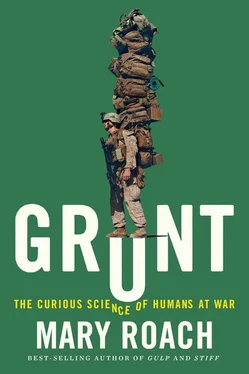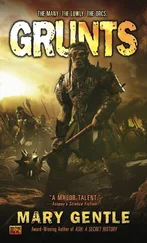The captain of the Greeneville exhibited what is known in these parts as poor periscope discipline. He scanned for about half as long as procedure called for. Another potential danger for a surfacing sub is “bow null.” If the front of a ship points straight into a submarine’s sonar array, the sound waves emanating from that ship’s propulsion are blocked by its own body and cargo. The Tennessee ’s safety officer compares it to “yelling through the trunk of a car to your kids in front of the car.” A helpful, if disquieting, metaphor.
It’s the weekend, which can be a more dangerous time to come up. Container ships that are nearing a port outside standard work-week hours will sometimes loiter, timing their arrival for Monday, when pay scales drop back to normal. A container ship is the size of a strip mall, but if its engines are silent, it’s all but invisible to the crew of a ballistic missile sub. Aboard the Tennessee , a sailboat is more worrisome than a warship. Now you understand how it came to pass that the USS San Francisco , in January 2005, ran into an undersea mountain. They’re very quiet, mountains.
Adding to stress levels: Last-ditch evasive maneuvers are out of the question. A surfacing ballistic missile sub is traveling between 6 and 12 miles per hour. “It’s like a baby crawling out of the way of a truck,” says the safety officer, as though yelling through the trunk of a car that there may be something just a little bit off with him.
Extreme caution is ever the mind-set. If a new sonar contact should appear on the screen during surfacing, an “emergency deep” may be ordered. Because without echolocation, you don’t immediately know how far off the other vessel is. “Be safe now and figure it out after,” the commanding officer said yesterday, as we dove to avoid a ship that would turn out to be several miles off. A ballistic missile sub is a boat without a destination, its course a series of evasions and nervous retreats. Any time a contact is calculated to be within two miles, the commanding officer is called. And, often, the navigator and the executive officer.
And there goes another night’s sleep. “I expect to be woken three or four times per sleep,” the navigator told me. Murray wakes up, too, because he has a speaker mounted on the wall of his stateroom, above his pillow, that picks up the conversation in the control room. He’s like a new mother with a baby monitor on the nightstand. “All of a sudden, out of a lot of background noise and chatter, you’ll catch a certain word or a change in the tone or volume of somebody’s voice. It just snaps you out of a sleep.”
Unsurprisingly, submariners have a robust tradition of caffeination. [58] To reduce troops’ load, the Army adds caffeine to gum or mints or foods that soldiers are already carrying, like jerky. Natick public affairs officer David Accetta feeds a Caffeinated Meat Stick to reporters who visit the food lab. To me, it tasted just like you’d expect caffeinated meat to taste. Accetta was taken aback. “Brian Williams loved them.” Or did he ?
The Tennessee left port with a thousand pounds of coffee. The world’s first nuclear-powered submarine, built in 1954, is now a floating museum in Groton, Connecticut, and if you tour it, you will see metal rings bolted to consoles and bulkheads at the different watch stations: cup holders! Caffeine is safe and effective but not without a downside. Depending on one’s sensitivity, it has a half-life of six to eight hours. Even if you have no trouble falling asleep after drinking coffee late in the day, you may wake more easily during the night because your nervous system is still aroused, your brain attuned to sounds and other stimuli that would otherwise go unheeded. The more poorly you sleep, the more caffeine you tend to consume the next day, and the more lightly you sleep the following night. And so on. As Murray said upon seeing me refill my mug, “That’s not a long-term solution, shipmate.”
We’re approaching periscope depth. The lights in the control room have been shut off. This is done for the benefit of the man at the periscope, who will shortly be taking a look around in the 5:00 a.m. darkness at the surface. To everyone else up here, many of whom are going on four or fewer hours of sleep, darkness is the opposite of helpful. Not only is it warm and dark in here, but because we’re nearing the surface, the submarine is now rocking gently with the swells. “Torture,” says the helmsman.
Torture was the word used by sleep researcher William Dement, who, as a student in the 1950s, helped Nathaniel Kleitman document Rapid Eye Movement (REM) sleep. Before there were eyelid electrodes and electrooculargraphs, there were grad students pulling all-nighters. “Staring at the closed eyes of human adults by the dim light of a 30-watt bulb in the middle of the night was sheer torture,” Dement wrote in a tribute to Kleitman, who is known in his field as “the Father of Sleep Research.” (Tougher yet was the job of the chaperone Kleitman insisted be present when the subject was female: watching someone else watching the eyes of a sleeping human all night.)
THE PHOTOGRAPH dates from 1938. Nathaniel Kleitman sits at a dinner table, knife and fork crossed in a slab of hickory-smoked ham. What’s unusual about this ham supper is that it took place in a cave 119 feet underground. Kleitman, with a graduate student assisting, spent thirty-two days in Kentucky’s Mammoth Cave investigating the cycles of human sleep and wakefulness. He wished to find out: to what extent are these rhythms tied to external cues and routines? If you took away the cues—sunlight, established mealtimes, regular business hours—could people slip easily into an altered routine? Going underground seemed like the easiest [59] Though not, as correspondence in the Nathaniel Kleitman Papers reveals, without its challenges. To avoid “the danger of rats jumping up,” the researchers’ beds were outfitted with special five-foot-high legs with “tin rat guards.” Alas, there was no rat guard for publicity-seeking tourist attraction managers and noisome reporters. Kleitman had made clear he wanted no press involvement, but about a week into the experiment, Mammoth Cave general manager W. W. Thompson sent a note down with the evening meal saying that reporters had somehow , mysteriously , found out about it and were clamoring for access. Kleitman did not go quietly. He asked to review the copy. He made News of the Day state in writing that they would “in no way ridicule the experiment.” Life magazine got the last laugh: A “printer’s mistake,” the editors claimed in a letter of apology, caused Kleitman’s title (“Dr.”) to be “transposed” with the “Mr.” before the name of his grad student.
path to an answer.
Submarines interested Kleitman, because, like caves, they present a sort of real-world laboratory for chronobiology. Kleitman, in turn, interested the Submarine Force. They were, as they are today, having some alertness issues. Kleitman came up with a watch schedule that took advantage of a submarine’s isolation from sunlight—the fact that it’s always, as Murray put it, “70 degrees and fluorescent.” It should thus be possible, Kleitman reasoned, to put each of three separate watch crews on a different schedule by staggering their waking hour, each crew beginning the day at a different time.
Beginning in 1949, three submarines, the Corsair , the Toro , and the Tusk , gave the Kleitman watchbill a two-week trial. At the end of it, Kleitman distributed questionnaires. “Should new schedule replace old?” read the last question. “Yes,” said 19 sailors. “No,” said 143. What happened? Catastrophic decompensation in the galley. Rather than cooking and cleaning up one breakfast, one lunch, and one dinner every twenty-four hours, galley crew had to do three of each, accommodating the different start times of each watch group’s “day.” The cooks were exhausted and peeved. The galley was a mess—“never clear and clean for more than an hour and a half,” causing every meal to be “flavored with the odor of the last, and the whole permeated with the aura of aged refuse.” And because a submarine’s galley doubles as its rec room, movies could no longer be screened. “Recreational activities had to be curtailed to such an extent that they degenerated to periods of loafing around trying to keep out of the way.” Friends who weren’t assigned to the same “time zone” were now isolated from each other. “It is considered neither desirable nor feasible to continue this experimental watch schedule any further,” concluded the final memo in the submarine folders of the Nathaniel Kleitman Papers.
Читать дальше












